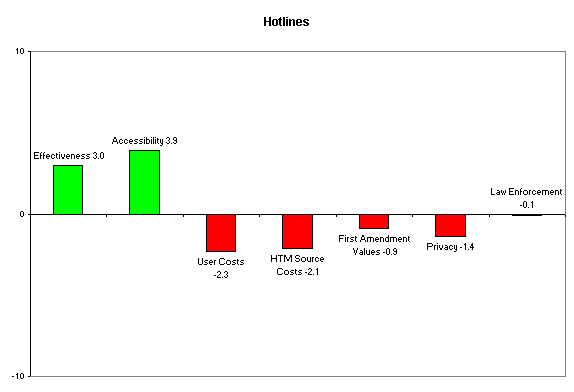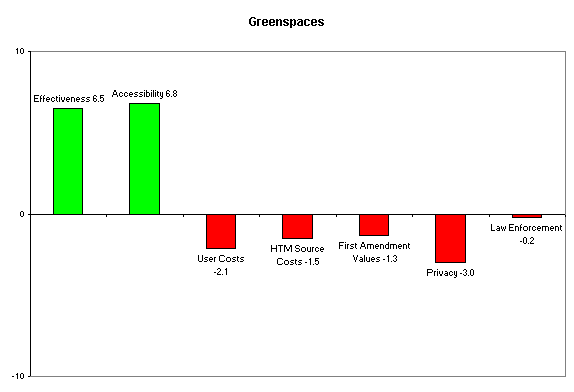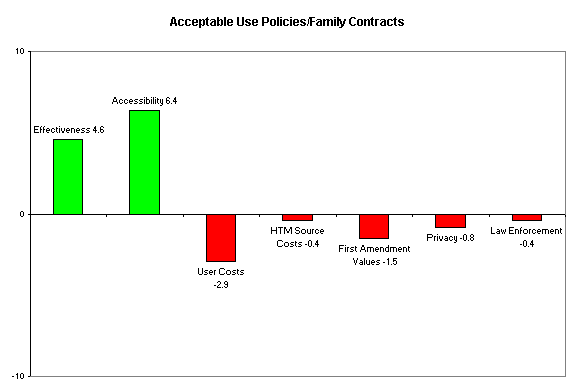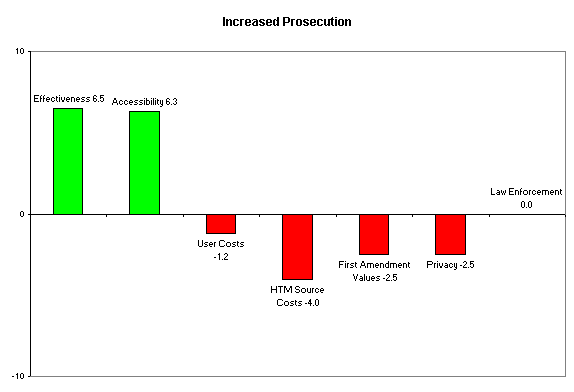|
F. Other technologies or methods
13. Hotlines
Creation of facilities for easy reporting of problems to the parties who can address them, either online or via telephone. Such hotlines would bring problems to the attention of both relevant government authorities and private sector groups that can act in response to reported problems. Activity levels in aggregate and general nature of complaints would be made public.

Commentary
- Some service providers and law enforcement agencies currently operate hotlines.
- While hotlines do not directly block access to harmful to minors materials, they can be an integral part of an effective child-protection effort.
- Hotlines would increase visibility and information regarding the extent of problems concerning the exploitation of children, both for public and governmental use. High user costs reflect the fact that consumers ultimately bear the costs of hotlines, which can be substantial.
- Hotlines have little or no adverse effect on privacy and First Amendment values.
- The effect on law enforcement could be both positive and negative. Because of increased reporting, more information about harmful to minors material would be available to law enforcement. At the same time, law enforcement might receive more baseless reports.
14. Greenspaces
The voluntary creation of lists of materials determined to be appropriate for children and provision, via a browser or an online service or server filters, of an environment that allows children to go to or receive only such materials.

Commentary
- Numerous greenspaces exist now, although many of them do not enjoy a high level of public awareness. Greenspaces may be very effective when they are readily accessible to children and when parents are involved in assuring that children use these spaces exclusively. It is unclear whether they are effective at blocking access to chat, newsgroups, or instant messaging.
- Effectiveness at protecting older children is limited, because they are more likely to seek access to content outside of the "walled garden" of greenspaces.
- Some of these content sources are available for a fee and thus impose a cost on consumers and other end-users. They may also impose some cost on publishers or compilers of greenspaces.
- While greenspaces impose little adverse impact on privacy and on lawful adult speech, concerns about First Amendment values relate to children's inability to access appropriate materials not incorporated into a greenspace.
15. Monitoring and time-limiting technologies
Use (typically at the PC) of software that creates logs showing details of a child's online activities and, optionally, enforces rules regarding the amount of time that may be spent online. Such systems may track both web use and email and instant messaging activities. In analyzing this technology/method, the Commission will assume that the child is told that the monitoring is taking place and that only the parent has access to the resulting information.

Commentary
- These systems are available in the marketplace at this time. Some of them are sold as part of a filtering or blocking system. They work automatically and thus are not adversely affected by the constant changes in content available on the Internet.
- Monitoring and time-limiting technologies can be effective when used in the home because they influence children's activities and require involvement of parents. These technologies can be effective for email and other non-Web communication, and for access to global content.
- Monitoring and time-limiting technologies encourage greater parental involvement in the child's online experience; however, because a parent learns of activities only after the fact, effectiveness in reducing accidental access to harmful to minors materials may be limited.
- Use of these technologies requires some technical sophistication on the part of parents.
- Consumers and other end users absorb monetary and time costs to use these systems.
- The inability of teens to access appropriate informative materials without parental supervision and oversight is reflected in ratings regarding adverse effects on privacy and First Amendment values. Privacy concerns may be raised when this technology is used in schools and libraries.
- These technologies do not impose costs on providers of harmful to minors speech.
- The logs created by these technologies can be helpful to law enforcement in identifying predators.
16. Acceptable use policies/family contracts
Establishment by a parent or an institution (school or library) of rules regarding the types of materials that may be accessed. Typically, such policies would be enforced by means of denial of further access in the event of a violation. Such policies may or may not be accompanied by monitoring that would allow the parent or institution to detect violations.

Commentary
- Examples of many different kinds of acceptable use policies and family contracts are widely available on the Internet.
- Involvement of parents and institutions in expressly establishing guidelines through an acceptable use policy or family contract can have a significant positive impact on awareness and behavior, although they do not themselves directly reduce access by minors to harmful to minors material. While this approach can address the extent to which children seek out material, it is of less help in addressing accidental access or incoming spam.
- These approaches impose some cost on families and other caregivers because of the time commitment involved for active implementation and involvement.
- This approach imposes negligible costs on providers of harmful to minors material.
- When used in schools or libraries in conjunction with monitoring, this approach may raise privacy and First Amendment concerns.
17. Increased prosecution
Governmental expenditure (at federal, state and local levels) of more funds to investigate and prosecute online activities that are unlawful. While this "method" assumes a change in current governmental activity, the Commission will analyze its likely effectiveness (and potential adverse impacts) to provide a basis for its recommendations. The Commission will assume that US law could not practically be enforced against all content sources located in other countries with differing legal standards for content.

Commentary
- This approach could be highly effective in reducing children's access to harmful to minors material because of its deterrent effect on publishers of illegal content. Targeted prosecution could show the US as an international leader, which might affect global enforceability over time. It is not clear that increased prosecution will have as significant an effect on content published outside the US, especially where the content might not be unlawful in the foreign country of origin.
- Costs to consumers of targeted prosecutions against clearly unlawful content would not be substantial. Sources of harmful to minors and lawful adult content could bear significant costs due to the need to assess the lawfulness of materials.
- Increased prosecution raises privacy risks because of law enforcement's increased efforts to obtain information about online activities. First Amendment concerns about increased prosecution relate to the chilling effect of investigation and decisions by lawful speakers to curtail speech to avoid risk of prosecution.
18. Real time Content Monitoring/Blocking
Use of real time monitoring methods to detect and block harmful to minors material sent via email, instant messaging, chat rooms and Usenet in addition to the web. Such monitoring assumes the ability to detect harmful to minors material in areas where filtering may not apply.

Commentary
- Products meeting this description are available in the marketplace.
- This technique can apply to messages (e.g., real time chat) that cannot be filtered effectively with automated processes.
- To be effective, real time monitoring may require human involvement.
- The expense of human involvement may be substantial.
- To the extent that these products are more effective, potential impact on First Amendment values and costs to sources of harmful to minors content are increased due to the risk of over-blocking.
|






